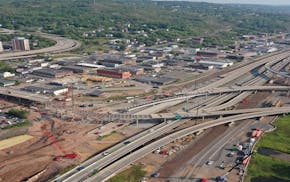The city of Minneapolis and all its people, homes and businesses used 10 billion gallons less water last year than they did 35 years ago. Customers connected to St. Paul Regional Water Services cut their overall water use by about a third over the same time. Duluth's residents and businesses dropped their water use by more than half.
About 2 million more people live in Minnesota now than were here in the late 1980s. Yet even with that growth, Minnesotans as a whole are using about 90 billion gallons less water a year to live and work — about an 8% drop, according to a Star Tribune review of data recently released by the Department of Natural Resources.
Residents, businesses and utilities are wasting less water and using it more efficiently. It's been driven by the unheralded but steady adoption of better fittings and appliances, everything from low-flow shower heads and dishwashers to high-tech sprinkler systems, said Annika Bankston, director of Minneapolis water treatment and distribution services.
"It's no one thing," she said. "It's 40 years of progress and what is happening here is common throughout the industry."
Similar drops in residential water use have been happening across the country. A 2020 University of California study found that Southern California residents had become so adept at reducing water use that it disrupted the flow of area sewage systems and raised the salinity of their wastewater. Metropolitan Atlanta reports that it has cut its per-person water use by 30% since 2000, and has been using less overall water even as its population has soared.
In Minnesota, the reductions have been driven by the state's most developed cities, said Erik Evans, spokesman for the DNR.
The savings have been enough to outpace major spikes in water demand from the state's fastest growing suburbs such as Lakeville, Woodbury and Blaine. But the gains in water supply savings have largely been counteracted by massive increases in agricultural irrigation.
It's hard to pinpoint which specific appliance or upgrade has done the most good.
The Metropolitan Council has been running a rebate program funded by the state's Clean Water Fund since 2015. It's helped 37 cities reward residents with more than $2 million for installing more efficient appliances, plumbing fixtures and high-tech irrigation controls.
The most popular upgrade is a low-flow toilet, 5,000 of which have been installed under the program, according to Met Council records. That action alone saves an estimated 60 million gallons a year.
"It's really encouraging," said Michelle Stockness, executive director of St. Paul-based Freshwater Society. "Inside the house has gotten much more efficient. Industry is being more efficient. Cities are aware water isn't unlimited. The question now is sprinklers — can we run them less and still have green lawns?"
In Minneapolis, water use has gone down in just about every sector that the utility measures, Bankston said.
The city's residential customers have gone from using an average 71 gallons a day to about 51 gallons. The biggest gains have been during the summer, Bankston said, when water use peaks.
"People are starting to do a much better job watering their lawns," she said.
In 2017, University of Minnesota researchers and the Metropolitan Council surveyed 1,000 homeowners to find out how much water people wasted when irrigating their lawns. The survey found that more than half of homeowners left their sprinkler systems to operate automatically, even in the rain. On average, residents watered 500 square feet of paved surfaces.
Sprinkler systems started to become vastly more efficient starting about seven years ago, said Kevin Buck, CEO of RainMaster, a lawn irrigation company based out of Minneapolis and Eau Claire, Wis.
Irrigation systems that run at a certain time all summer are being phased out, he said.
New systems can use weather data to adjust and skip watering. They calculate how much water in the soil is lost to evaporation based on sun, wind and heat. He estimates that newer systems can cut water use by about 30%.
"It's the standard now; it's what we advise everyone to use," Buck said.
Lawn irrigation has long been one of the biggest uses of public drinking water. In some of the newest suburbs, where many single-family houses are being built and new sod is being laid, cities are using up to four times as much water in the summer. The DNR's goal is to cut the summer peak usage down to no more than 2.9 times more than winter.

State's fastest paddler. Guinness record holder takes aim at Minnesota.
Walz selects leader for new state agency focused on children and families

Parts of Twin Ports Interchange project could open in fall; completion is in sight
Man sentenced to 16 years for fatal sucker punch on St. Paul light rail platform

